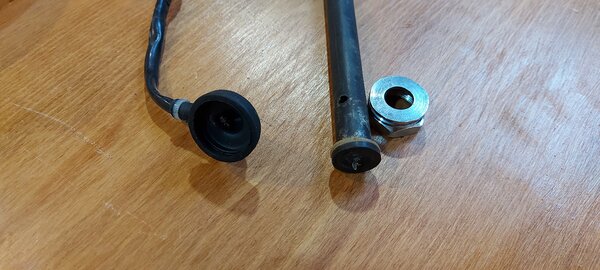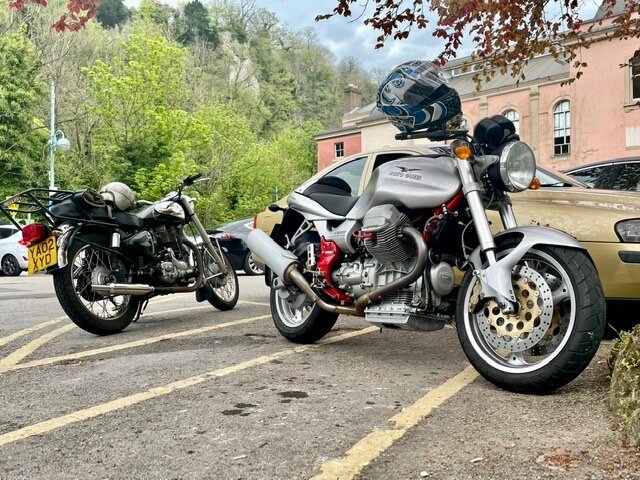Leaderboard
Popular Content
Showing content with the highest reputation on 05/03/2022 in all areas
-
I found getting anything near a reliable reading next to impossible, especially with the Roper plate in situ which can catch the dipstick. I followed Phil's advice on my HiCam and Sporti (the V11 broadsump should be the same) and "overfilled" to just below the level of the Roper Plate which you can see by looking through the dipstick hole. This works a treat for me and I have not experienced any problems with pressurization3 points
-
I didn't want to get into "pumping losses" and drain back speeds etc. Honda RC30's when they first started racing them were destroying big end bearings because the oil pumped into the heads couldn't drain back to the sump fast enough so the oil level dropped enough to cause cavitation. Robert Dunlops bike in the pits at the WSB round back in 88 or so had extra external drain back lines from the head to the Crankcase but I think the real fix was to reduce the qty pumped there to start with. Honda had excess oil going to the heads so they fitted restrictors in the end I think. Ciao2 points
-
Probably because it's a more indicative indication of the level when running as opposed to the level when every last bit of oil possible has drained back to the sump which is not really the case in operation. Could also be because for long journeys and top offs the engine is more likely to be warm when oil is added, who really knows they are Italian and I doubt there's really that much thought or science involved along with the typical translation vagaries. It's of little consequence whichever way you do it really. Might reflect a few hundred ML of difference. Not sure the differential expansion between mineral and synthetic has anything to do with it as I doubt there's any real difference between the two anyway. If anything I would have thought it would be the other way around with the Mineral oil relying on Viscosity Index Improvers that expand as the oil temp rises unlike Synthetic oil which doesn't need them. Ciao2 points
-
Here are the oil cooler lines at the right front of the sump that should be evaluated (check tightness; clean, dry, spray foot powder, ride and look for discoloration). [These are the earlier "AN"/JIC flare fittings. Later V11 have double O-rings that could benefit from renewal.]2 points
-
All 3 of mine dissolved. If leaking higher up it can catch onto a cable/wire/hose and follow it down to show up almost anywhere. I'd recommend buying one now to have on hand whatever you find.2 points
-
Possibly, you could benefit from snugging those "worm-screw adjustable collars." Yet, still good to inspect that breather hose along its full course. If it is the culprit, the top of your motor well be wet as seen in jimmyegypt's images. There is the method of cleaning everything and spraying on a coating of dry "foot powder", go for a ride and observe where the powder discolors, revealing the leak source. Gently snugging the sump fasteners may reveal loose ones. Same for checking tightness of the oil lines at the right front of the sump. This image is of the crankcase vent oil return line ("retour de fuites") at the rear of the sump from the left side of the spine frame, but illustrates that the later oil lines, for the oil cooler as well, have double O-rings . . .2 points
-
Hi, FWIW, I installed a "high current" starter relay as described here previously. I got a relay & harness assembly from Greg Bender (This Old Tractor) that was basically "plug and play". His assembly comes with a relay base that piggy backs on to the existing relay bank, a 30/87 harness runs down to the starter solenoid (one lead plugs into starter, the other plugs into existing 87 from OE start relay) and a fused batt Pos lead to HC relay term 30. It works great and mimics what gstallons described earlier. On another note, I checked solenoid draw. With the engine cold, jumping from bat Pos to the solenoid terminal on the starter my intial draw was 7amps and as the starter engaged and began cranking the draw dropped to 4amps. On my 2nd attempt the intial draw was 4amps and remained at 4 amps. I didn't try a 3rd time. Oh...this was on my '03 Lemans. PS - I also posted this at "(solved) Had to get a jump start from roadside assistance...."2 points
-
How did you get to post such nice images? It maxes out at 200k for me... Thank you!1 point
-
1 point
-
Thanks Docc, A fellow Guzzisti and I arrived at the same conclusion last night. Appreciate the confirmation though.1 point
-
1 point
-
1 point
-
1 point
-
My observation is that the oil check after the pump stabilizes the oil distribution (not necessarily "warm") has more to do with how much volume is distributed through the engine, and into the rocker/valve covers ( a lot!), in order to ensure adequate oil volume remains in the sump for the pick-up.1 point
-
The "spray foot powder" will help solve the mystery. It very well could be more than one source.1 point
-
Having a black engine does not help the trouble shooting. I did check the tightness of the hoses connections to the oil radiator.1 point
-
Best post I found on the breather hose, with images of both ends, from @Jimmyegypt: Coming from the clutch area behind the motor, looking from the left: Into the bottom of the spine frame at the front:1 point
-
1 point
-
p6x, check your breather pipe from the top of the block to the frame, this is notorious for degrading and leaking oil. I had to replace mine after 17 years. Rob1 point
-
Moto America was kind enough to make the two rounds available to watch on YouTube. I have a different take on Gagné's crash. Petrucci had just beaten the lap record, and Gagné was feeling the heat from behind. He set his own lap record and then went down. This is what happens when you are under pressure from a pursuit. We could agree that Gagné would not have crashed if Petrucci had been off pace. On a side note, Gagné is the past participle of the verb "Gagner", "To win". -Jake Gagne: Jake wins. -Jake à gagné: Jake won. The proper way to write Jake' surname would be with an accent on the final e. "é". Else the pronunciation would be like a silent "e". But as I discovered myself, in the US the administration can't put accents. Anyway, I am eager to see what happens on the next race.1 point
-
Technology Livecycle Management: Reliability Engineering: Maintenance programs are largely provided by the Sustaining organization and are best described as a hybrid of assembly/disassembly guidelines, used initially by Manufacturing. For some which are more reliant on 3rd party equipment, the programs are based on OEM maintenance manuals and recommendations. Over time, maintenance programs are supplemented with sporadic best practices, lessons learned and technical alerts (all usually triggered by Maintenance observations). Owners made progress in using RCM (Reliability Centered Maintenance) to improve the maintenance programs for several technologies and focus less on time-based maintenance. The selection of RCM initiatives and other Sustaining priorities is largely subjective, and a methodical data-driven set of rules does not exist. Outcomes of the failure and investigation process are reasonable with high visibility (C, M) failures when considering the links to root causes and required actions, as there is usually a suitably strong investigation team assigned for the duration needed. However, the business lacks a holistic prioritization process for reliability investigations, appropriately trained people (especially in the current DIY Maintenance mindset) , and necessary data access to drive concrete failure analysis efficiently for lower visibility (and often more frequent) failures. Finally, visibility on TCO is exceptionally poor for most technologies. Thoughts: Most of the recurrent issues that affect our motorcycles (any brand and model) are described and recorded in the forums. There is no Motorcycle manufacturer effort to drive the process. Their involvement seem to stop after they have designed the bike, industrialized it, and sold it.1 point
-
After 160k miles on my 94 Camaro, that LT-1 motor was leaking pretty bad. Also that optispark. My 08 vette LS3 is easier to work on and has a lot of go. Good luck with the Mustangs. I have a buddy in the Mustang club. One fellow shows a black '65 GT fastback with red stripes and interior. It's an absolute knock out.1 point
-
Apparently during the test drive the technician was ran off the road by another car.... What was the Murphy law for this? if anything can go wrong, it will?0 points











